It is not difficult to make a garage grounding if you know the installation requirements and the features of the electrical installation. It is necessary if this object is used not only as a car storage room, but also as a workshop where repairs can be carried out. In the repair process, power tools are used, even stationary ones, which are powered by a current with a voltage of 380 volts. And this is dangerous for humans.
The content of the article:
- Requirements for PUE
-
What types of grounding exist
- TN-C
- TN-C-S
- TN-S
- TT
-
Scheme of arrangement of the ground loop
- Vertical earthing
- Horizontal earthing
-
Do-it-yourself garage grounding instructions
- Installation work
- How to maintain garage grounding
Requirements for PUE
The rules are a voluminous document consisting of main chapters. One of them at number 1.7 is called "Grounding and protective measures for safety." It states that there are several grounding schemes, one of which can be used in a garage. It all depends on the voltage that is used to power electrical equipment and tools.
This indicator of power supply directly depends on the resistance of the ground loop. Because the higher the resistance, the slower the current passes through the conductor from which the garage ground is formed. And it has to go fast.
In this case, the human resistance must always be greater than the ground resistance. If a person touches an electrical installation where an electricity leak has occurred, the latter must pass through a conductor that has less resistance. A person is a conductive object.
The ratio of voltage and resistance of the ground loop is given in the table.
| Voltage, V | Resistance, ohm |
| 127 | 20 |
| 220 | 10 |
| 380 | 5 |
Paragraph PUE 1.7123 says which conductors cannot be used as grounding:
- pipes of gas, water and heat pipelines, sewerage and pipelines through which explosive and flammable substances move;
- water supply, if insulating inserts are inserted into its lines;
- cables, if cable wiring is organized;
- tubular wires;
- metal hose;
- lead braids of wires and cables.
What types of grounding exist
According to the rules for electrical installations, clause 1.7.3, there are 6 power schemes used in electrical networks. 4 types are acceptable for a garage:
- with a combination of a protective and zero circuit, designated as TN-C;
- with partial overlap - TN-C-S;
- with dedicated protective circuit and zero - TN-S;
- with dead-earthed neutral - TT.
Choosing one of the power schemes, you will need to select the scheme and the ground loop in the garage.
TN-C
The most common connection system. 4 wires are inserted into the input shield: three are phases, one is zero. This zero simultaneously performs the functions of grounding. There is no separate ground conductor, and this is a clear savings. But this scheme has several drawbacks. One of them is serious.
For example, somewhere in the area where the neutral wire was laid from the transformer to the garage, a break occurred. Three-phase power is supplied to the object, but there is no grounding. It turns out that if you turn on the electrical appliance, a potential will be applied to its body. And if a person touches the metal case with his hand, then he will be shocked.
It is easier with a single-phase connection, where the voltage is 220 volts. If the zero, which is also a grounding conductor, breaks, then electrical installations cannot be turned on. No power - no danger of getting an electric shock. In this regard, a three-phase connection is dangerous.
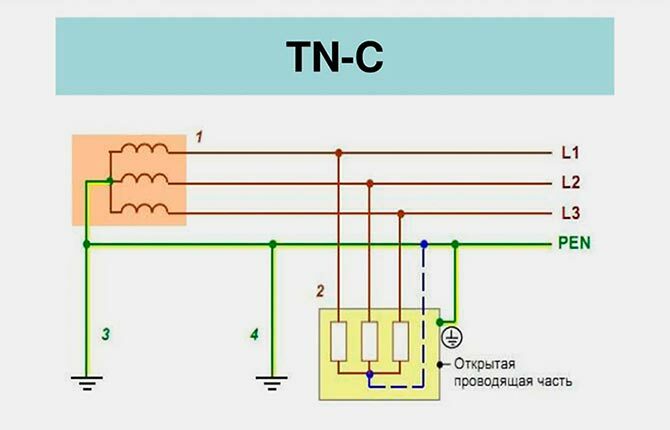
TN-C-S
A safer wiring option. Here, as in the previous case, 4 wires come out of the transformer substation: three phase, one zero. But on the site to the garage, the latter is divided into two. And the garage already includes 5 circuits:
- 3 phase;
- 1 zero;
- 1 ground.
The grounding itself can be carried out either at the substation or at the disconnection site.
If single-phase power is introduced into the garage, then the neutral wire can also be divided into 2. Instead of a two-wire cable, a cable with three cores will be connected to the electrical panel.
This garage connection diagram must have an RCD that is inserted into the zero circuit. The reason is that if the combined conductor is damaged, a potential may form either from the side of the transformer, or from other garages connected to a single network.
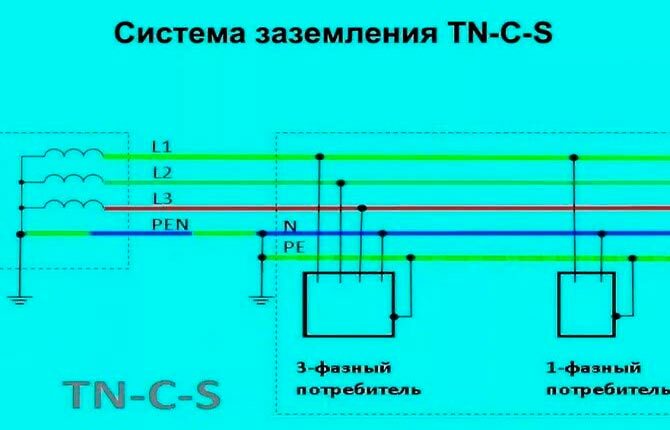
TN-S
The most reliable garage connection system. Here, 5 single-core cables or 1 five-core cables are led into the shield from the substation. For 3 phases, for zero and ground, separate circuits are carried out. If the zero core suddenly breaks, the grounding will work independently. It is impossible to get an electric shock in this circuit.
But this is the most expensive connection option, so it is rarely used in garages.
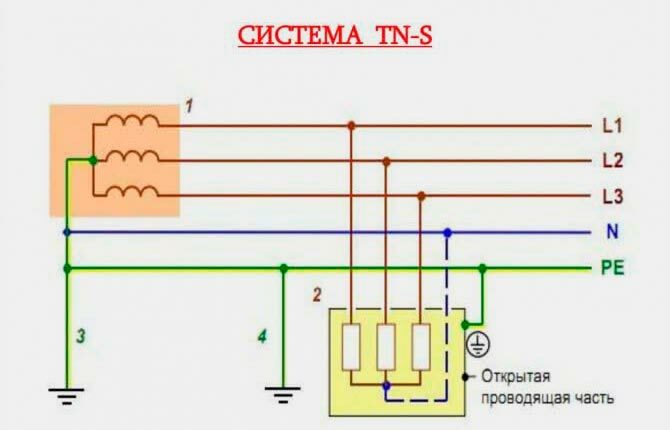
TT
The most common scheme, and not only in garages. If the power supply of electrical installations is three-phase, then a four-core cable is carried out, 3 cores of which are phases, one is zero. The latter is necessarily grounded, hence the name of the power supply - with a solidly grounded neutral.
Grounding is created separately. To do this, a wire is drawn from each installation, which is connected to the ground loop. The latter is made by hand. For example, 3 steel pins up to 3 m long are driven into the ground, which are tied with a metal tape.
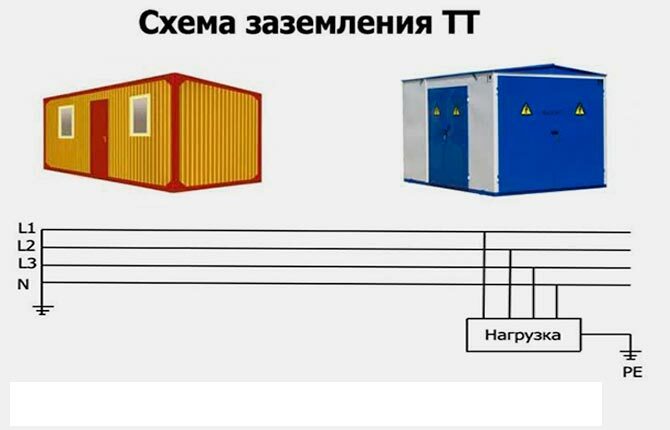
An individual ground loop is a reliable design if done correctly. It provides 100% electrical safety for the garage.
Scheme of arrangement of the ground loop
Before you make grounding in the garage with your own hands, you need to understand the structure of the system. And it consists of metal conductors. Some are vertical, others horizontal. The vertical ones are called electrodes.
Vertical earthing
There are recommended and non-recommended materials for the manufacture of vertical grounding elements in the garage. The former include steel corners, pipes with a diameter of more than 32 mm and a wall thickness of more than 3.5 mm. To the second - steel reinforcement, round timber with a diameter of less than 10 mm.
The depth of their driving depends mainly on the level of groundwater in the area. It is necessary to make sure that the electrodes do not reach the water. But there is another requirement - the electrodes are clogged below the freezing level of the soil.
To drive the electrodes into the ground, their ends are cut at an angle of 45º - a wedge is made of them for more convenient immersion in the ground.
Horizontal earthing
For its manufacture use:
- steel tape with a thickness of 4 mm and a width of 40 mm;
- wire with a diameter of at least 10 mm.
And if the vertical ground electrodes are only included in the outer circuit of the garage grounding system, then the horizontal ones are both in the outer and inner. They are laid from electrical installations to a grounding structure located outside the garage, consisting of electrodes and horizontal elements connecting them.
We bring to your attention an article about grounding the gas boiler.
Do-it-yourself garage grounding instructions
There is no need to make a complex ground loop for a small facility like a garage. Therefore, it is proposed to choose one of 3 options:
- Linear, where the electrodes are placed on the same line - not the best option.
- Closed in the form of a triangle, circle or rectangle. This type is more reliable, because if one of the jumpers breaks, the circuit will work (from a closed one it turns into a linear one).
- Complex configuration. It is used if the area allocated for the grounding structure is small.
Many garage owners make grounding by eye. Electrodes are driven into the ground at a distance of 1 m from each other at the corners of an equilateral triangle. They are tied with a steel strip using electric welding. Then the resistance is measured. If it is more than the standard (8 ohms), then more electrodes are added, making a complex configuration.
You can reduce resistance in 2 ways:
- increase the conductivity of the soil, which is impossible with your own hands;
- increase the contact area of the electrodes with the medium.
The second option is implemented like this:
- or increase the number of electrodes;
- or choose the depth of their laying greater.
Installation work
For example, a scheme was chosen for connecting horizontal and vertical elements in the form of a triangle with sides of 2-3 m. This means that this form with dimensions must be applied to the ground near the garage. It can be right behind the wall. You can't do it in the basement.
Then either dig a trench around the perimeter, or a triangular pit. Digging depth - 70-100 cm. At the corners of the triangle, prepared electrodes are driven into the ground to a depth of 0.5-1.0 m.
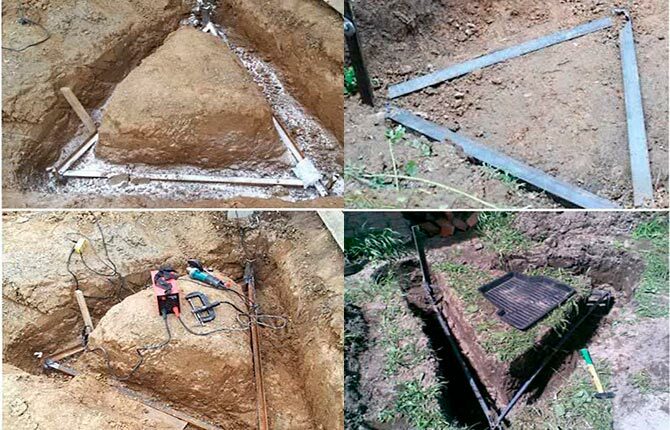
It is impossible to drill wells and lay electrodes in them. Loose soil - high resistance. So just hit it. Painting them is also prohibited.
A few recommendations:
- You can drive in with a sledgehammer, if the length of the vertical ground electrodes is 1-1.2 m. If it is more, then you need to use a perforator, a vibrator.
- If the length of the electrode is large, for example, 3 m, then it can be made in pieces by connecting them together with a threaded sleeve. This will make driving easier without the use of a ladder. You can weld elements, but a coupling is better.
- If the hammered element rested against a solid object, for example, a stone, then there is no point in hammering. It is better to cut it off and drive a new one next to it. It is possible to connect 2 rods by increasing the area of the ground electrode.
The electrodes are driven in, it remains to tie them. The steel strip can be welded to them or connected with bolts and nuts. The second option is better, because welding in the ground is exposed to moisture, which causes it to rust. The latter reduces contact, which means it increases resistance.
Bolts don't rust. But there is a chance that they will loosen, so two nuts are screwed onto one bolt. One as a locknut. The joints must not be covered with soil - it must be located on the surface. The reason is the most vulnerable places in the garage grounding structure. Therefore, they must always be in sight for maintenance and repair.
To the triangular circuit from the garage, a horizontal grounding conductor is drawn along the shortest route. It is also fastened with bolts or welding.
If inside the garage the conductor can be laid in an open way, then outside only with laying in the ground.
Now you need to check the resistance of the structure made. To do this, you can use a multimeter. If the resistance of the garage is greater than the standard, then it is worth adding several electrodes by driving them in so that they touch the horizontal jumpers. They need to be attached to them.
You can check the resistance in various home ways without using measuring instruments. For example, using a light bulb with a power of 100-200 watts. It must be screwed into the cartridge, one wire of which is connected to ground, the other to the phase. The bright light of the light bulb indicates that the ground loop is made correctly. If the light is dim, then somewhere there is a weak contact in the connections. It will have to be found and corrected.
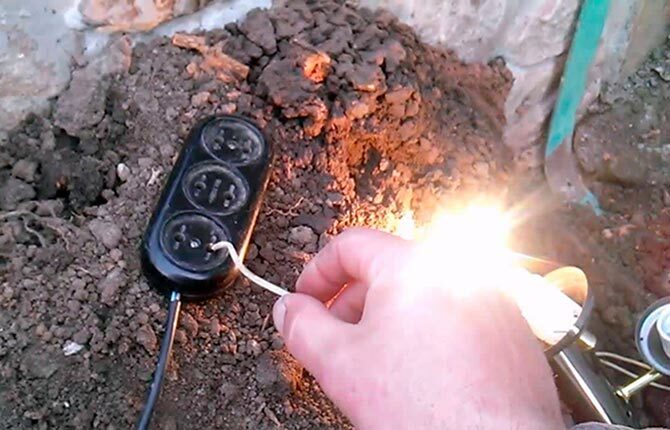
The resistance should not change in any weather.
Inside the garage, the laid common conductor must be connected to the switchboard. Better through RCD. It is from the connection point that grounding wiring will be carried out to all power-consuming devices and equipment: sockets, lamps, a drilling machine, welding machine And so on.
The last stage is backfilling the pit or trenches. The soil must be well compacted.
In a TT system, low resistance is great. In the TN-C-S system, this characteristic should not fall below 0.4 ohms. Because this indicator is a characteristic of the transformer. And if it is lower in the garage grounding, then the resistance of the overhead line laid from the substation will go to the garage circuit, which is not very good.
How to maintain garage grounding
Over time, the grounding created in the garage will lose its characteristics. The end of the metal structure is one - destruction under the influence of natural loads. But the operating time can be extended if the circuit is periodically serviced:
- Once every six months, check the structure for breakage of its sections.
- Pay attention to the thickness of the installed elements. It should not decrease, because the smaller the thickness, the greater the resistance.
- Once every 12 years, check the grounding in the garage for resistance.
In fact, it is not difficult to organize grounding in the garage with your own hands. You just need to strictly follow the technical rules, instructions and recommendations, pay special attention to safety. If there is no confidence in the quality of the final result, then it is better to invite specialists.
Video about grounding in the garage with your own hands:
Dear readers, most of you have garages. Many of them have grinding and drilling machines that must be grounded. Therefore, share your experience in the comments, who and how assembled the ground loop. Bookmark this article so you don't lose any helpful tips.


